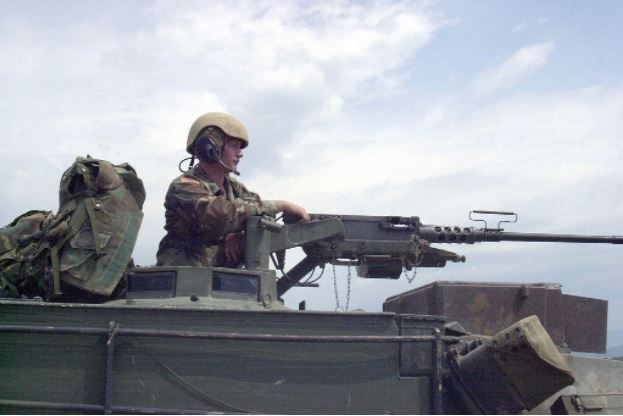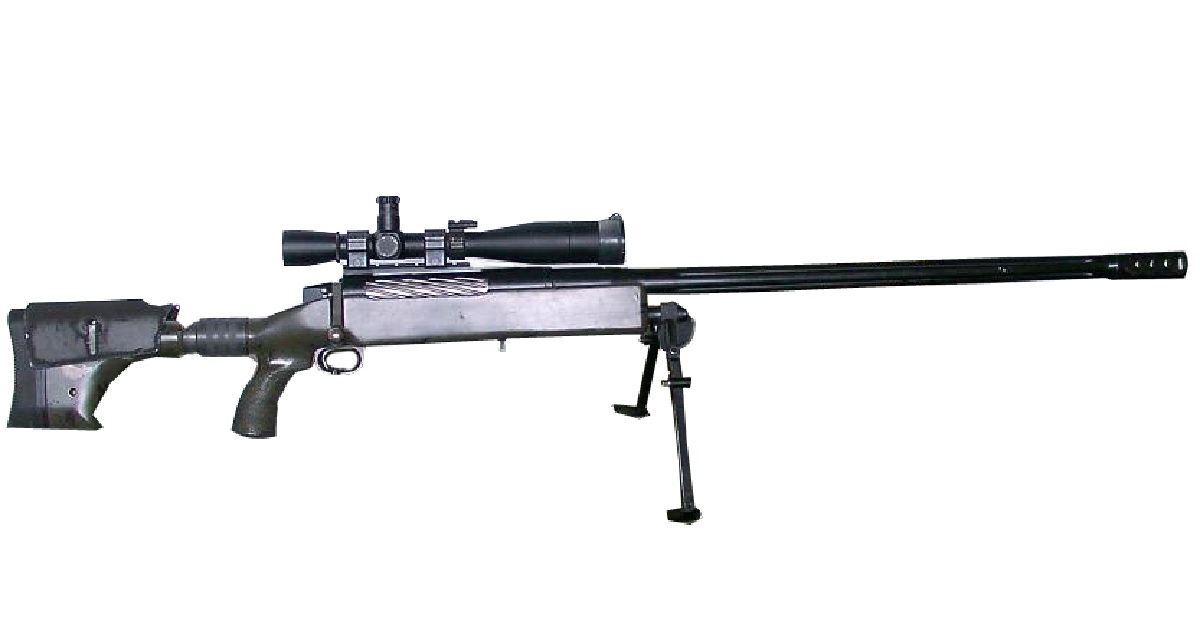
Featured image courtesy of the U.S. National Archives
It is the slow, deep, beat we all know that thumps right through your chest.
Whether it is perched atop an M2 Sherman or an M1 Abrams, the iconic sound carries more weight and (perhaps) history than any other weapon in the US Arsenal. That sound that gun is, of course, the Ma Deuce.
Though it is perhaps the least forgotten weapon of all time, Ian McCullom featured its form, history, and function in the video Ma Deuce: The Venerable Browning M2 .50 Caliber HMG on Forgotten Weapons. Check it out below!
The gun’s story starts with General Pershing in WW1, who immediately recognized the U.S. lacked a heavy MG and cartridge suitable for use against Triple Alliance aircraft and (yet to be developed) tanks. The Army passed the memo to who else but the hero of American gun design, John Browning.
Never one to pound sand on novel designs when old ones would suit just as well, Browning quickly scaled up his M1917 .30 caliber machine gun. It took him, Winchester, and Colt less than one year to develop the new cartridge and a complete working prototype.
Despite the incredible development speed, the machine gun debuted just too late for the Great War, and the 10,000 ordered by the US Military were never utilized. Just a few were put into production as the M1921 .50 Cal in a water-cooled anti-aircraft configuration for use by the U.S. Coast Guard.
The machine gun’s basic design has not changed since that time.
It is a short recoil-operated, belt-fed machine gun that fires from a closed bolt. Upon firing, the barrel itself reciprocates a short distance, imparting momentum to the bolt and bolt carrier. The bolt unlocks and continues to the rear, ejects a case downward, and pulls a new cartridge with it from the belt.
As the bolt attains its full rearward travel, the driving spring and compressed buffer disks push it forward as it chambers the new cartridge and advances the belt. Under automatic fire, a full lock and ignition of the cartridge are achieved well prior to full forward travel of the bolt, barrel, and barrel extension. The gun operates at about 450-600 rpm, though aircraft varieties, (AN/M2, AN/M3) are significantly faster at up to 1300 rpm.
The M2 also provides a semi-automatic setting, which, coupled with its closed-bolt operation, allows for astounding accuracy.
Gunnery Sgt. Carlos Hathcock used a customized M2-HB to make the longest confirmed kill in history while deployed to Vietnam in 1967. That shot was 2500 yards, and the record stood for 35 years.

The cartridge was as significant a development as the MG itself. According to some like the American Rifleman, it was influenced by Germany’s semi-rimmed 13.2×92 mm SR, but this is debatable as the American cartridge’s development appears to have begun before the discovery of the German round. Regardless, the rimless .50 BMG (Browning Machine Gun) has excellent similar terminal ballistics and could penetrate .9 inches of face hardened steel plate at 200 yards.
Unlike smaller calibers like the 30-06, it has a large enough projectile to carry a wide variety of ordnance and material, like high explosive, incendiary, or large hardened penetrators.
Well prior to WW2, the M1921 was improved by a Springfield armory engineer, Dr. Samuel Green. He reconfigured the charging handle to cam downward before travel giving a mechanical advantage to the user requiring much less force from the user to compress the massive recoil spring. Greene also gave the MG the ability to be belt-fed from the right or left without significant time or parts.
As time progressed, the receiver was developed to be universal and usable either with a water or air-cooled barrel. By 1933, all of these improvements made the guns much more flexible to suit the needs of different services: water cooled, heavy barreled, or light barreled for aircraft with a higher rate of fire as the AN/M2.
Through the ’30s, the Navy and Navy air service made extensive use of the design, particularly aircraft. The AN/M2 was an excellent compromise between the heft and low velocity of auto-cannon and the weakness of rifle caliber MGs.
The P-47 carried up to 8 AN/M2 in the wings, and bombers like the B-17 were positively bristling with them in every direction. From half-tracks to heavy tanks, M2s were mounted to anything on the ground that could carry them. The Maxson mount would even carry up to four on an electrically mounted turret on the back of a jeep. Modern evolutions of this design lasted until the mid-’80s.
Though ostensibly for air defense, the HMG was utilized extensively against infantry, emplacements, and light vehicles in practice. It may have been most famously fired by Audie Murphy as he stood heroically on a burning tank destroyer, single-handedly repelling a German attack and elminating more than 20 assailants. By the end of WW2, more than two million M2s would be produced in all different configurations.
After the war, their use in aircraft would start to be phased out as the development of weapons like the 20mm rotary cannon and air-to-air rockets replaced it, but the M2’s emplacement on ground vehicles, ships, and boats remained.
Today, the United States is replacing the M2 with the M2/A1. Though little changed in basics, It now has the added advantage of a genuinely quick-change barrel, which, unlike its predecessor, does not have to be timed and headspaced after each barrel exchange. Also, a new flash suppressor was added that reportedly lowered the prodigious muzzle flash by 95%.
As the longest-serving weapon in the U.S. Military and in use by nearly one hundred nations, the M2’s heart-stopping sound is unlikely to be silenced any time soon.
What do you think about this story? Share this out on Facebook and Twitter and let us know!


